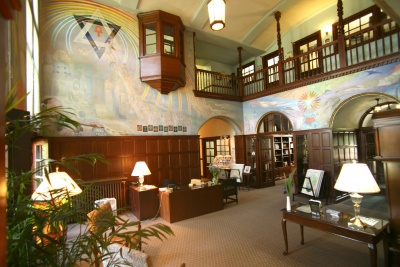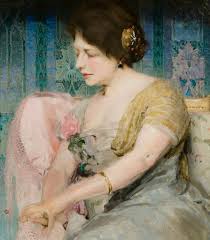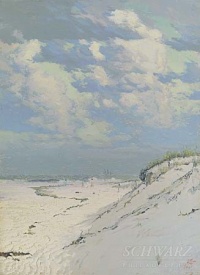Richard Blossom Farley
Richard Blossom Farley was a Philadelphia painter who created the murals in the lobby of the L. W. Rogers Building, headquarters of the Theosophical Society in America with the sponsorship of Georgine Wetherill Smith. He preferred to drop the name Richard in preference to Blossom or Blossom Farley.
Early life and education
Farley was born at Poultney, Vermont on October 24, 1875, to teacher Dickerson Harvey Farley and Freberne Lucia Blossom. The young family relocated to Trenton, New Jersey by 1880, and two more sons were born: Marcus and LeRoy. The father became an instructor and then professor in the State Normal School. The boys attended the New Jersey State Model School in Trenton; Marcus trained as a civil engineer; and LeRoy became a dentist.
Richard Blossom Farley was trained at the Academy of Fine Arts in Philadelphia when Cecilia Beaux and William H. Chase were instructors in portraiture. After the academy awarded him an $800 European Traveling Scholarship, he went to Paris and studied under James McNeill Whistler in 1898-1899.[1] He also spent time in England, Belgium, and Brittany.
By 1914, Blossom Farley was a well-established artist, with many exhibitions and prizes to his name. He married Abigail Rosenthal.[2] A son was born on December 3, 1918 and named after his father. A daughter, Abigail Freberne Farley, was born on August 3, 1920. They lived in rural Newtown Township, Bucks County, north of Philadelphia and just west of Trenton, and may have done some farming for a time.[3] By 1925, however, the artist was again living in Philadelphia and maintaining a studio there.[4] After Mrs. Abigail Farley died on January 2, 1926, the young girl was sent to live with her aunt Miriam who was married to a wealthy Pittsburgh steel manufacturer, Samuel Heppenstall.[5] The outcome of the son, Richard Blossom Farley Jr., is unknown.
Artistic career
Blossom Farley worked steadily as a prolific and successful studio artist, painting landscapes for sale at exhibitions, and portraits on commission. During World War I, he worked for the U. S. Shipping Board as a "camoufleur," painting ships in camouflage designs to protect them from attack.[6] His works were often exhibited in conjunction with artists from the "New Hope School" of Pennsylvania impressionists.
The artist's work was featured in numerous exhibitions such as these:
- 1906 – Philadelphia Academy of Fine Arts
- 1911 – Peabody Institute, Baltimore
- 1912 – Pennsylvania Academy of Fine Arts
- 1913 – Art Club of Philadelphia
- 1913 – MacDowell Club Gallery, New York City
- 1915 – Silver Medal, Panama Pacific Exhibit in San Francisco
- 1916 – Arlington Galleries, New York City
- 1921 – Carnegie Library, Fort Worth
- 1922 – National Academy of Design, New York City
- 1925 – Trenton Fair Art Club
He received significant prizes and awards:
- 1897 – Charles Toppan Prize, as student at the Pennsylvania Academy of Fine Arts
- 1898 – European Traveling Scholarship Prize, Pennsylvania Academy of Fine Arts ($800)
- 1910 – Fellowship Prize, Pennsylvania Academy of Fine Arts ($100)
- 1912 – Fellowship, Pennsylvania Academy of Fine Arts ($100)
- 1913 – Gold Medal, Philadelphia Arts Club Exhibition
- 1914 – Fourth W. A. Clark Prize ($500) and Honorable Mention, at Corcoran Art Gallery, Washington, D.C., in an exhibition of contemporary American oil paintings
- 1915 – Silver Medal Panama-Pacific International Exposition, San Francisco
His works are represented in the permanent collections of the Pennsylvania Academy of Fine Arts with "Morning Mists;" the Reading, Pennsylvania Museum with "The Passing Cloud;" and at the Corcoran Art Gallery, Washington, D. C. with "Fog" and "Blue and Gold." Well-known subjects of his portraits include Trenton Mayor Frederick William Donnelly, Miss Sarah Y. Ely, and Professor Austin Apgar. A portrait of Christine Wetherill Stevenson can be seen at the Philadelphia Art Alliance.
Murals include:
- “The Peace Treaty with the Indians” at the New Jersey State Normal School, Trenton.
- Decorations of the dining room and music room at the Arts Alliance Building, 251 S. 18th Street, Philadelphia, which Mrs. Shillard-Smith described as "exquisite" and "notable for their delicacy of color and beauty of workmanship."[7]
- Dining room of the New University Club.
- Lobby of the L. W. Rogers Building, headquarters of the Theosophical Society in America.
Philadelphia Sketch Club
The Philadelphia Sketch Club remembers him this way:
In our membership files are the decaying sketches of Richard Blossom Farley. His works languish in museums, not being exhibited at the Allentown Art Museum, the State Museum of Pennsylvania, the Corcoran Gallery of Art, the Reading Museum of Art, and the Pennsylvania Academy of the Fine Arts.
Born in Poultney, Vermont the 24th October 1875, he joined our fair institution in 1896 and remained a member until his death. Nor was he merely a member in name, but was quite active, being involved in decorating many of the Club's affairs, a frequent exhibitor and indulger and singer in the Club's Epicurean revels, and a member of the Grub Club... In 1914, Blossom gave the after dinner talk at one of the Club's monthly meetings, his subject landscape painting.
Fortunately, we can see his work. His landscapes of the New Jersey shore are, at least for now, to be found at the Schwarz Gallery. His portrait of remarkable Christine Wetherill Stevenson, actress, playwright, and philanthropist, can be seen at the Philadelphia Art Alliance, which she founded.
Blossom was also known for his murals. He did murals for the dining room of what was the new University Club in 1930, for which the architect was Grant Miles Simon, another member of our Club. Another mural was for the New Jersey State Normal School in Trenton, now the University of New Jersey. Blossom fulfilled yet another commission to decorate the four walls of the two-story reception hall of the Rogers Building at the Theosophical Society's Olcott Center in Wheaton, Illinois. But Blossom abandoned pointing murals, complaining that housepainters were making more.
It should be remarked upon that Blossom joined other Club members in helping the military during the Great War. At the request of fellow Club member Brigadier General Charles T. Cresswell, they painted twenty-six "Landscape Targets" (3 1/2 feet by 14 feet each) to be used at Camp Meade. Blossom was also among the Club members who served the Camouflage Section of the U. S. Shipping Board, preparing the designs and superintending the painting of various ships.
Richard Blossom Farley was a slender man with a well-trimmed beard. Dying in 1954, he had lived long enough to be remembered by our William H. Campbell. In a letter that Bill wrote to me about Blossom, "He dressed like a gentleman of the early 1900's with a derby, rolled up umbrella, high top shoes, etc. One day he came to lunch and was delighted to report that he was now the last living student of Whistler, since he had read that the only other living student had just died."[8]
Theosophical Society involvement
Several people in Blossom Farley's artistic circle in Philadelphia were members of the Theosophical Society. Theosophist friends included Georgine Shillard-Smith, her sisters Christine Northrup Wetherill Stevenson and Sara Northrup Wetherill Logan, her brother Col. Samuel Price Wetherill, Jr., brother-in-law Robert Restalrig Logan, and Dr. James Henry Cousins, along with numerous visitors to the Logans' estate, "Sarobia." Blossom Farley never became a member ot the Theosophical Society himself, however.
 
|
Olcott Murals
Georgine Shillard-Smith brought Blossom Farley to the headquarters campus of the American Theosophical Society in Wheaton, Illinois. The organization has since been renamed The Theosophical Society in America. The campus is known as "Olcott" since it was named in honor of TS Founder Colonel Henry Steel Olcott. In 1927, work had been finished on a new headquarters building, and Mrs. Shillard-Smith had committed to see it "decorated."
At the end of 1929 she brought Mr. Farley from Philadelphia to see the new headquarters building. By December he had measured the spaces in the reception hall and had completed some preliminary drawings. At the summer convention of 1930 he displayed sketches to the membership, and the project was approved in a resolution at the annual meeting.[9] Members immediately subscribed to donate $1415 of the $2500 required for the murals. Mrs. Shillard-Smith led a fundraising campaign to raise the rest – no easy feat during the Great Recession. Later that year Mrs. Shillard-Smith reported that he was hard at work in his studio. He painted in oils on canvas that had been cut to fit the spaces. She wrote:
If you could only peep into his studio and see the high wooden frame that he constructed with hinged parts to carry the canvas, see the succession of living models from which he makes drawings for all the figures, and then follow him into the fields where he collects leaves showing the evolution of the leaf form, and then into the Academy of Natural Science, studying prehistoric animals, intent on the accuracy of those forms, and then watch him brooding in the long evenings over the best possible expression in art of his many ideas that he aims to incorporate into this great inspirational work, perhaps you would catch a glimpse of the devotion, skill and persistence necessary to materialize so great a vision...
When one considers the amount of material, work and knowledge required, the price seems inadequate, as Mr. Farley has been working ceaselessly since receiving the commission, and will be much pleased if he can complete it in a year’s time. He must devote himself entirely to this work, not undertaking any other. What a comment this on the small remuneration received by artists! — but how fortunate we are to have so fine an Interpreter of our philosophy...
Mr. Farley is interested in Theosophy and eminently fitted to visualize for us this conception of evolving life. In addition to his years of education as an artist, he has specialized in the study and portrayal of evolving life form for the Academy of Natural Sciences, in Philadelphia.[10]
The artist visited for several weeks in 1931 and installed the first panels on the south wall. Mrs. Shillard-Smith wrote a descriptive article about the mural and the artist in September, 1931, entitled "Life Aspiring through the Ages."[11] The west wall was completed in April, 1933, and by November 2 the east and north panels had been installed. Blossom Farley gave a talk to the Olcott Lodge that day on the symbolism of the murals.[12]The staff and membership have been delighted with the murals ever since.
Tree planting
While visiting the Theosophical Society in Wheaton, Illinois in 1933, he was present when trees were planted in recognition of Armistice Day, November 11. The artist, who was then completing his murals, was asked to speak on that occasion:
Mr. Richard Blossom Farley, celebrated landscape, mural and portrait painter from Philadelphia who has been painting the mural for the Headquarters reception hall, was also one of the Speakers for the occasion. Mr. Farley, who has sponsored the planting of more than 5,000 trees, mentioned other worth while efforts to perpetuate trees in America and the widespread awakening of greater interest in nature.[13]
Advice on care of portrait
The close relationship that developed between the artist and the staff at Olcott us evident in his exchange of correspondence with Etha Snodgrass, National Secretary. In May, 1934, she wrote to Mr. Blossom Farley to ask his advice about removing an adhesive incorrectly applied to Gutzon Borglum's oil portrait of Madame Blavatsky. The artist wrote back recommending a technique that would be suitable to restore the painting.[14][15]
Later years at Sarobia
By 1931, Blossom Farley was spending time at Sarobia, near Eddington, Pennsylvania, the estate of Robert Restalrig Logan and his wife, Sara Northrup Wetherill. He attended a birthday party for Theosophist poet Dr. James Henry Cousins.[16] When the artist contracted tuberculosis, the Logans invited him to live at Sarobia, which had become an artists' colony with a bohemian reputation. Troupes of actors spent the summer at Sarobia performing in a barn converted into a playhouse. The Logans were vegetarians, raising their food in gardens and greenhouses. They were animal lovers – very active in the American Anti-Vivisection Society and in the Theosophical Order of Service. Sara maintained her connection with the Art Alliance in Philadelphia, with which Blossom Farley was also associated.
Sara Logan died on December 2, 1935, and bequeathed to Farley $200 of her personal estate.[17] The artist continued to live at Sarobia for the rest of his life, enjoying the rural existence and the company of Robert Logan in frequent chess games. Construction projects took up much of his time. He built a four-story tower where he stayed in winter, and an underground cave home for hot summers. He lined the cave beautifully in river stones and concrete.[18]
Blossom Farley died on September 10, 1954. Two years later, his friend Robert Logan also passed away, leaving the Sarobia estate to the state, where it became the Neshaminy State Park.
Notes
- ↑ Georgine Wetherill Smith, "Life Aspiring through the Ages," World Theosophy 1:9 (September, 1931), 707-708.
- ↑ Philadelphia, Pennsylvania, Marriage Index, 1885-1951, marriage license 313268.
- ↑ U.S. Census, 1920.
- ↑ "Trentonians Listed Among Prominent Artists to be Exhibited at Fair This Year" Trenton Evening Times (September 20, 1925), 20.
- ↑ U.S. Census, 1930.
- ↑ U.S., World War I Draft Registration Cards, 1917-1918.
- ↑ Mrs. G. Shillard-Smith, "Headquarters Decorations" The Theosophical Messenger 18.12 (December, 1930), 267.
- ↑ Bruce H. Bentzman, "Past Members of Note: Richard Blossom Farley," Philadelphia Sketch Club web page.
- ↑ "Convention Resolutions" Theosophical Messenger 18.8 (August, 1930), 172.
- ↑ C. Shillard-Smith, "Headquarters Decoration" The Theosophical Messenger 18.12 (December, 1930), 267.
- ↑ Georgine Wetherill Smith, "Life Aspiring Through the Ages" World Theosophy 1.9 (September, 1931), 707.
- ↑ "What Lodges Are Doing" The American Theosophist 21.12 (December, 1933), 284.
- ↑ "Armistice Day Tree Planting" The American Theosophist 21.12 (December, 1933), 272.
- ↑ Ethna Snodgrass letter to Richard Blossom Farley. May 3, 1934. Sidney A. Cook Papers. Records Series 08.05. Theosophical Society in America Archives.
- ↑ Richard Blossom Farley letter to Ethna Snodgrass. July 23, 1934. Sidney A. Cook Papers. Records Series 08.05. Theosophical Society in America Archives.
- ↑ "Dr. Cousins Feted at Birthday Party" Trenton Evening Times (August 2, 1931), 32.
- ↑ "Mrs. Logan's Will Filed for Probate" Trenton Evening Times (December 12, 1938), 14.
- ↑ Paul Michael Bergeron, Sarobia: Sanctuary for Human Beings, Birds and Animals. E-book published through Lulu.com. 2017.
Additional resources
- Peter Hastings Falk, Who Was Who in American Art, Sound View Press, p. 1995.
- Robert Wilson Torchia, New Jersey Remembered, Schwartz Gallery, Philadelphia, pp. 58-59.



